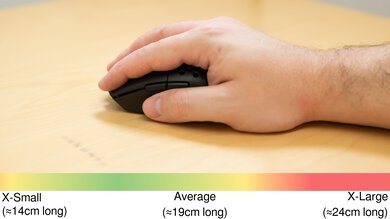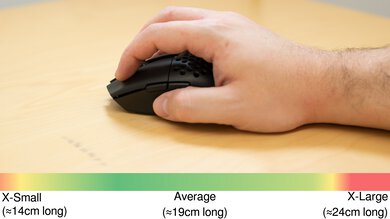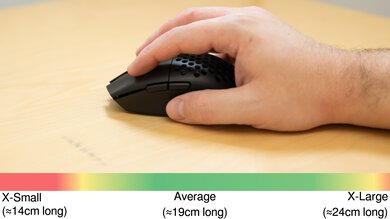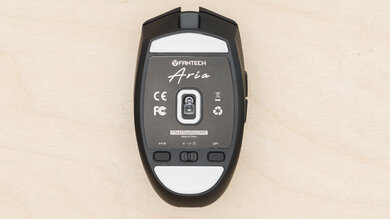The Fantech Aria XD7 is a lightweight wireless gaming mouse. It has a comfortable, egg-shaped body and includes the option to swap the palm rest plate between a lighter version with honeycomb cutouts and a marginally heavier solid plastic alternative. It's one of the first mice released using PixArt's new top-of-the-line PAW 3395 sensor and uses tactile Kailh and Huano dot switches for its buttons.
Our Verdict
The Fantech Aria XD7 is satisfactory for office and multimedia work, though it's not designed specifically for this use. Its built quality is excellent, and its egg-shaped body is comfortable, though a bit small for larger-sized hands. This mouse connects wirelessly with a USB receiver or via Bluetooth, and you can reprogram buttons using the customization software.
- Extremely lightweight.
- Comfortable egg-like shape suitable for most hand sizes.
- Excellent build quality.
- Scroll wheel lacks L/R tilt inputs and doesn't unlock for free-scrolling.
- A bit too small for larger hands using a palm or claw grip.
The Fantech Aria XD7 is an excellent FPS gaming mouse. It's extremely lightweight, well-built, and has a comfortable egg-like shape that's well-suited for most hand sizes using a claw or fingertip grip. It has excellent click latency and a very accurate and consistent sensor, and its feet glide very smoothly on mousepads and desks.
- Extremely lightweight.
- Very low click latency.
- Comfortable egg-like shape suitable for most hand sizes.
- Excellent build quality.
- A bit too small for larger hands using a palm or claw grip.
The Fantech Aria XD7 is a good MMO gaming mouse, though it isn't designed for this usage and has far fewer programmable side buttons than most dedicated MMO options. It feels sturdy and has a comfortable egg-like shape. Although, it's a bit too small for a palm grip if you have larger hands. Performance-wise it has excellent click latency and outstanding sensor performance all around.
- Extremely lightweight.
- Very low click latency.
- Comfortable egg-like shape suitable for most hand sizes.
- Excellent build quality.
- Not nearly as many programmable side buttons as a dedicated MMO gaming mouse.
- A bit too small for larger hands using a palm or claw grip.
Changelog
- Updated Jan 05, 2024: We've updated the CPI graph displayed in the Sensor Latency section of this review. Our results remain the same, but these graphs have two new columns with results from the Delay At Half Movement and Delay To End Of Movement tests.
- Updated Oct 02, 2023: We've added text to this review for the new tests added in TBU 1.5.
- Updated Oct 02, 2023: We've converted this review to Test Bench 1.5. This update adds a new Main Button test group, which provides button actuation data and switch information. We've also made minor changes to how we calculate the Office usage score. For more details, you can see our full changelog here.
- Updated Dec 09, 2022: We've converted this review to Test Bench 1.4. This update modifies our Hand Size Recommendation test, adding a more granular hand size recommendation chart. We've moved several minor tests into different test groups, removed the Travel usage, and added a new Raw Performance usage. For more details, you can see our full changelog here.
Check Price
Differences Between Sizes And Variants
The Fantech Aria XD7 has both a white and black colorway option. We purchased and tested the black color variant, and you can see the label for our unit here.
Popular Mouse Comparisons
The Fantech Aria XD7 is a lightweight wireless gaming mouse with a somewhat egg-shaped body design. It's one of the first mice to use the newly-released PixArt 3395 sensor, and it has excellent click latency and sensor performance overall. Fantech also advertises the use of Huano dot switches for the side buttons and middle click button as well as Kailh 8.0 switches for the left- and right-click buttons. These buttons feel very crisp, making this mouse a great option if you've been off-put by mushy-feeling buttons on other mice or prefer more tactile buttons overall. Many community members online have drawn visual comparisons between this mouse and other egg-shaped mice, including the Razer Orochi V2 and the Logitech G305 LIGHTSPEED. The Aria XD7 is a bit larger and marginally lighter than the Orochi V2 and about the same size and significantly lighter than the Logitech G305. For a more detailed comparison between these mice, see our side-by-side comparisons below.
For more recommendations, see our picks for the best gaming mouse, the best wireless gaming mouse, and the best lightweight mouse.
The Fantech Aria XD7 and the Logitech G305 LIGHTSPEED are wireless gaming mice with similar shapes. These two mice have similarly excellent gaming performance, but the Fantech is significantly more lightweight. It also supports Bluetooth and recharges with a USB-C cable, while the Logitech doesn't support Bluetooth and uses disposable AA batteries.
The Fantech Aria XD7 and the Razer Orochi V2 are wireless gaming mice with similar egg-like shapes. Both mice are relatively small, but the Fantech is a bit larger, making it better suited for a wider range of hand sizes. The Razer has somewhat better click latency; otherwise, the two deliver very similar gaming performance. The Fantech also recharges using a USB-C cable, while the Razer uses disposable AA or AAA batteries.
The Logitech G PRO X SUPERLIGHT and the Fantech Aria XD7 are lightweight, wireless gaming mice with comparable gaming performance and virtually the same weight. The Logitech feels a bit sturdier, has a somewhat larger size, and its shape is more accommodating to a wider range of hand sizes. It also has lower click latency and marginally better sensor performance overall. On the other hand, the Fantech has Bluetooth support, which the Logitech lacks.
The Fantech Aria XD7 and the Razer Viper Mini are similarly-sized, lightweight gaming mice that weigh virtually the same. The Fantech connects wirelessly with its USB receiver or via Bluetooth. On the other hand, the Razer has lower click latency, but it's a wired-only model.
Test Results

The Fantech Aria XD7 has a nearly symmetrical egg-shaped body made of matte black plastic. The left side is slightly concave, and the right side has a side panel badge with a stylized 'Aria' logo. The palm rest panel is removable, and you can swap between a lightweight honeycomb option or a solid plastic option. There's no RGB lighting, but there's a CPI indicator light behind the scroll wheel that you can customize using the software.
The Fantech Aria XD7 has a storage compartment for its USB receiver under its removable palm rest.
This mouse has excellent build quality overall. The side buttons and left- and right-click buttons feel very crisp and have good tactility. The palm rest panels are held magnetically and easy to swap out, but they feel very solid when in place. There's some minor flexibility in the body, noticeably on the underside. However, this doesn't present any issues during regular use.
The Fantech Aria XD7 is extremely lightweight. The weight measurement was obtained with the honeycomb palm rest attached. Swapping this palm rest out for the alternate solid plastic palm rest adds 1.4g. It's possible to use this mouse without a palm rest installed to save additional weight, but this significantly affects the ergonomics and likely won't be comfortable.
The Fantech Aria XD7 is a small to medium-sized mouse with an egg-shaped body that's nearly symmetrical, though the left side is slightly more concave than the right. This mouse is very lightweight, making it easy to control quickly, and it's a good fit for most hand sizes using either a claw or fingertip grip. Although, it's fairly short for larger hands using a palm grip.
The Fantech Aria XD7 has an advertised battery life of up to 30 hours.
This mouse has an excellent paracord-like charging cable that's very lightweight. However, it retains distinct kinks from its packaging and is a little stiffer than many similar cables on other mice.
The Fantech Aria XD7 has excellent mouse feet; they glide very smoothly on mousepads and directly on desks. There's a slight scratching sound gliding on a desk, but this doesn't affect the gliding experience. There's a replacement set of feet included in the box, and Fantech also sells alternate feet on its website.
The left- and right-click buttons on this mouse use Kailh GM 8.0 mechanical switches.
You can reprogram all buttons on this mouse except for the Bluetooth pairing button found on the bottom of the mouse. The left- and right-click buttons use Kailh GM8.0 switches. Fantech also indicates that the side buttons use Huano Black Shell White Dot switches, while the scroll wheel button uses a Huano Black Shell Blue Dot switch.
This mouse has excellent click latency. The latency is higher and significantly less stable when using a Bluetooth connection, but this is normal. A Bluetooth connection isn't recommended for gaming, especially for reaction-based or competitive games.
The available polling rate options are 125Hz, 250Hz, 500Hz, and 1000Hz.
The Fantech Aria XD7's mouse wheel has a rubber grip that feels very precise. The definition between steps is clear but fairly light, and the scroll button press feels crisp and satisfying.
The Fantech Aria XD7 has very straightforward, easy-to-use software that offers a full range of expected options, including button mapping, debounce time adjustment, lift-off distance calibration, and custom profile settings you can save to onboard memory.
Note: The score of this test is based on the companion software's features and not its overall performance.































